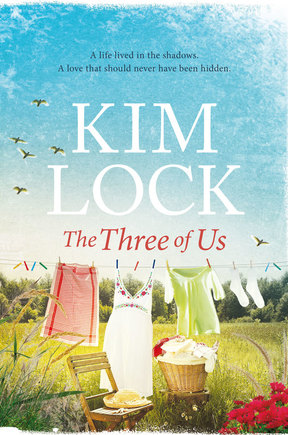Author Kim Lock writes novels that examine the turbulent gamut of human emotions and challenge our sense of the dichotomies of right and wrong, of good and bad. She takes situations and twists them into something new and unusual; she creates circumstances that test our comfort zone of the familiar and offer up a thought-provoking alternative. Her characters are easily relatable but at the same time caught up in events that we can’t quite believe are unfolding…and this produces the best kind of question for a reader of fiction: what would I do in that situation? How would I react? What are the options? How could I choose? Is it kinder to do this, or that?
In her latest novel, The Three of Us (Pan Macmillan 2018), Kim invites us to experience the intimacy of relationships spanning over 50 years. To say anything much at all about the plot would be to give away the elements of surprise, but suffice to say that this novel was nothing at all that I expected. It is a fresh perspective on the tradition of marriage; it is a tender exploration of the capacity of the human heart for love and devotion.
Set in a small town in South Australia, where everyone knows everybody else’s business, where – at the start of the novel, in 1960, gossiping neighbours and prying eyes are a given amongst the knitting circles and the backyard barbeques – the upholding of family reputations is paramount. Actually, while the narrative does begin at that point, the book itself begins with a short section set in the present, with 75-year-old Thomas opening up to a psychologist about what is bothering him. There are four or five such sections spread throughout the book, each pulling us back to the now, and reminding us that however far back we travel with the narrative (and whatever events have unfolded over the years), we will eventually end up here, in the present day, with Thomas looking back on his life and his choices. It is a structure that works well, demonstrating the passage of time, and emphasising the notion that life is fleeting, and that the issues and tribulations that plague us at points in our lives may seem nonsensical or trivial later on; the matters we were most concerned with (reputation, standing, acceptance) may vanish into unimportance. Conversely, the yearnings and desires we most fervently pursued only in the privacy of behind closed doors, or even in the stillness of our own hearts, may prove ultimately to be of most import.
This is a story about family, about the many shapes a family may take, about the many forces that help create those shapes, about the people that combine together – some related, some not – who form the basis of that familial bond. And while the book is an easy read, it does challenge us on our pre-existing notions of family and all that it means. It carries us along on a journey where we think we know exactly where we’re going, and where we’ll end up, but gradually we realise we are at a completely unexpected place, and we think, oh, we’re here, how did that happen? And how on earth am I going to find my way again? And how can I navigate when all the rules seem to have changed?
What I found really interesting about this novel is that it is written in a style and begins in a period when I could comfortably insert my own grandparents or parents into the characters’ lives, but then as the circumstances unfold and the story develops, and begins to deviate into another direction, I question my knowledge of my own history and the stories of those I think I know. For who, really, is privy to the intimacies of a marriage, a partnership, but the people involved? And who comprehends the sacrifice and loyalty and devotion and love of family members without experiencing the particulars of that individual situation?
This is a heart-felt and compassionate novel that makes us question our beliefs. It offers characters that are flawed and failing, flailing along as they attempt to make their way in the world. It demonstrates the capacity of the human heart to expand and to practice acceptance, tolerance and gratefulness.
Today Alison Evans published an article in The Saturday Paper about gender nonconformity and misunderstandings related to non-binary identity. Even though Alison’s writings are on a completely separate subject, somehow that article – and the themes of this book – have coalesced in my mind to form a curious itch to know more about difference and to comprehend diversity. I want to be brave enough to challenge my own preconceived notions, compassionate enough to welcome ‘the other’, insightful enough to recognise the shifting goalposts of a changing world, big enough to allow other people the space to tell their own stories, and small enough to understand that not everything ‘new’ is actually new, but may be only unusual or different to me, while being perfectly normal and usual and non-surprising to somebody else.

